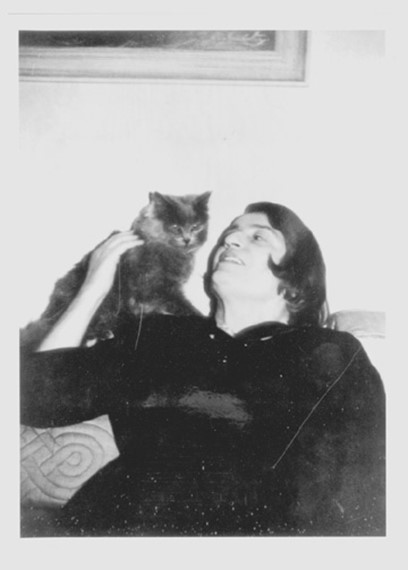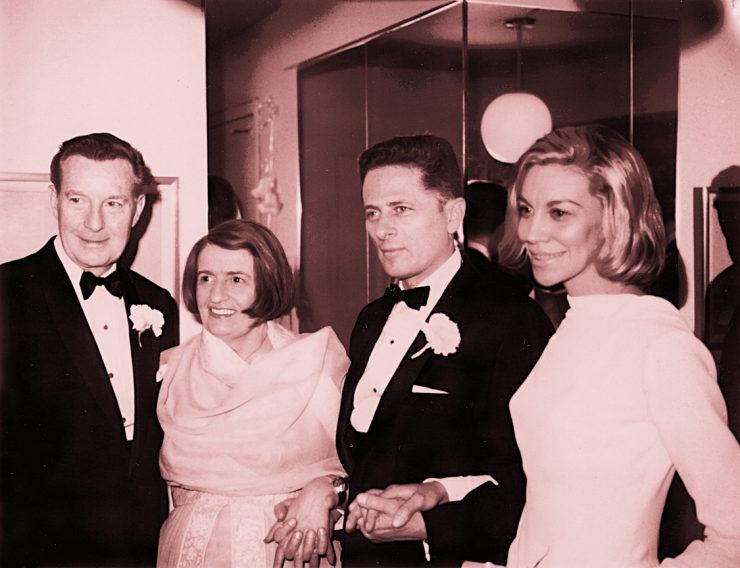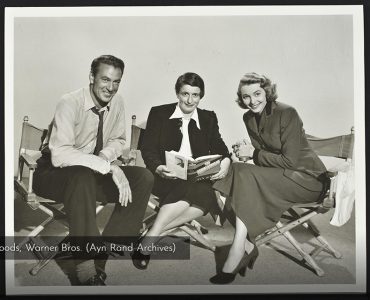In 2001, the Ayn Rand Institute Press published Facets of Ayn Rand: Memoirs by Mary Ann Sures and Charles Sures, based on forty-eight hours of interviews conducted by oral historian Scott McConnell from September 1998 to January 1999. Twenty years later, these entertaining and informative personal reminiscences still merit careful study and reflection. New Ideal is proud to present the entire book online in eight installments.
Start with Part 1 here
CHAPTER SEVEN
PERSONAL FAVORITES
ARI: Did she have any favorite foods?
MARY ANN: Ayn had a sweet tooth. She loved milk chocolate, fudge, and Godiva chocolates.
ARI: Any stories connected with them?
MARY ANN: Five‐and‐dime stores with candy counters sold chunks of milk chocolate. I said earlier that she didn’t like to ask for favors, but chocolate was the exception. When I was living in New York, more than once she asked me to bring her some chocolate if I were near a dime store. She insisted on paying, of course. She enjoyed it as dessert, with black coffee.
ARI: What about the fudge?
CHARLES: There was a delicious fudge we used to bring her from Washington. It was made by hand, in small batches, by a local woman, and sold only at Garfinckel’s, a D.C. department store. As an indication of how much she liked it, she once said, jokingly, “I would sell my soul for that fudge!”
MARY ANN: There’s an amusing story connected with fudge, and it’s an example of her sense of humor. Leonard was fond of the fudge, too. One year, I sent him two pounds, each pound in a separate box — one with her name, one with his. I expected him to deliver a box to her. Well, apparently, he didn’t see the labels. And when he called to thank us, he thanked us for both pounds. But, by the time he called, most of the fudge had been eaten by Leonard and some friends. So, I phoned her to report the mishap and to say that I would send her another box. She said something like “Do you mean to tell me that he ate both boxes?” She sounded surprised and somewhat indignant. I said, jokingly, “Ayn, it’s not as if he had just challenged the validity of the Law of Identity!” There was a pause, and then she answered, “Well, it’s not that bad. But it’s close.”

Ayn Rand and Thunderbird, 1964
(Photo courtesy of the Estate of Ayn Rand)
CHARLES: Ayn discouraged gift giving. However, not once did she ever refuse the fudge or discourage us from giving it to her. Of course, we got around the gift‐giving restriction by offering it as a “non‐gift.” We stayed over at the O’Connors’ a number of times when we visited New York, and the fudge was a gift to the hostess. She said she would accept it as a “non‐hostess.”
ARI: And did you bring her Godiva chocolates?
MARY ANN: No, that was never necessary. She kept herself fully supplied with Godivas! B. Altman had a Godiva counter which she visited. She enjoyed everything about them — the chocolates, of course, but also the lovely gold boxes they came in, and the neat, little compartments inside the boxes. She saved the boxes, using them for storage of small personal things, like costume jewelry which fit nicely into the compartments. And once, she cut out Christmas crowns from the gold boxes for Oscar and Oswald, the toy stuffed lions.1
She enjoyed the Godivas after dinner and before bedtime. When I stayed over with her, bringing out the box was a nightly ritual. She had sampled all the Godiva chocolates, and had her favorites. One was called “open oyster” — a milk chocolate shell filled with hazelnut praline.
ARI: Were there other foods she particularly enjoyed?
MARY ANN: The only fruit I ever saw her eat was Italian prunes. She called them “manageable” — they were small, easy to hold, had a firm texture. She enjoyed certain Russian food — especially borscht and beef Stroganoff. She made, or had Eloise make, her recipe for the Stroganoff. One of her favorite restaurants was the Russian Tea Room on 57th Street, where she enjoyed the borscht and appetizers called pierogies. Eloise also made Ayn’s recipe for Russian nut cake. That was a household favorite.
CHARLES: She liked miniature Danish pastries served with the coffee. Incidentally, she always took her coffee black, diluted with cool water. But when coffee was served to guests, it was always accompanied by heavy cream.
She also liked Asian food. When she came to Washington, she enjoyed going to Trader Vic’s. And at the Sheraton Boston, where she sometimes stayed when in town for the Ford Hall Forum, she enjoyed the Polynesian‐type restaurant. She was also fond of the small, dollar‐size pancakes that were served at a restaurant in the Watergate Hotel in D.C. She also liked eggs Benedict, and often ordered it when she was out for a business lunch.
MARY ANN: Even though she watched her weight, she usually had dessert. One New York restaurant served an ice cream sundae that was topped off with a mound of spun sugar; it looked like spun gold; she loved its sparkling quality. Another restaurant, La Maison Japonaise, served a hot fudge sundae in a large goblet, and she recommended we all have some after dinner. At Trader Vic’s, she enjoyed the ice cream ball rolled in coconut and served with chocolate sauce.
ARI: Anything she didn’t like?
MARY ANN: Salads — lettuce, tomatoes, and so forth. Whenever Eloise prepared dinner, there was never a salad at Ayn’s place. She once referred to salads as “grass” — which I’ve since learned is a Russian way of viewing salad.
ARI: Alcohol?
MARY ANN: She didn’t drink; she didn’t like the effects of alcohol. But she didn’t frown on others drinking socially. Whenever there was a New Year’s celebration at her home, Frank put out bottles of liquor — whisky, vodka, etc. — for those who wanted it. And there was always champagne at midnight. She took a sip for the occasion, that’s all.
ARI: Let’s turn to clothing.
MARY ANN: Her favorites were her outfits designed by Adrian, which she had purchased in Hollywood. They were classic designs, and she carried them well in spite of being rather short. She loved the feminine, dramatic look Adrian created. I’ve mentioned the navy blue outfit worn with the polka dot blouse. There was also a beige wool suit with a straight, slim skirt and a belted jacket with pockets. It made her look taller, and it was slenderizing. She had a floor‐length, black dinner dress; its simple lines and long sleeves gave it an austere look which was relieved by a white collar. It had a nunlike quality — she called it her “Mother Superior” dress. She also had a stunning evening dress with a long sleeve on one arm only, leaving the other arm naked. She loved capes, too, and had one in black velvet.
She didn’t like shapeless garments, like shifts — loose dresses without waistlines. We had a discussion about them once, and she knew exactly why she didn’t like them.
ARI: What did she say?
MARY ANN: That they were too unstructured and didn’t flatter the body; they looked like something you would put on if you were marooned on a desert island and desperate for something to wear — as if no thought had been given to them. That’s how she characterized them.
ARI: What about casual clothes, like slacks?
MARY ANN: I’ve seen pictures of her from the Hollywood days where she is wearing slacks. She was thinner then. When I knew her, she had stopped wearing them. She thought a woman had to be slender to look decent in slacks.
ARI: What type of shoes did she wear?
MARY ANN: Ayn had beautiful legs. She knew it, and showed them off in high heels and sheer stockings. She especially liked platform shoes because they added to her height. There was a store on 57th Street she frequented because they had a good selection of platforms when no one else did. In the seventies, when high platforms with thick, high heels were in style again, she was delighted and bought a pair. But they were clunky and difficult to walk in; she sprained her ankle and had to stop wearing them, much to her disappointment.
CHARLES: If I may, I’d like to interject here with an anecdote about her legs. A group of her friends met at the O’Connors’ apartment one evening to watch an interview show she had taped earlier. When it was over, she asked us for our reactions. I don’t remember the specific comments, but everyone was complimentary about her performance. When we finished with our remarks, she asked if that was all. We were, to a person, perplexed. What else was there to say? She then said that she was disappointed that no one had a comment about how good her legs looked! It’s not that none of us noticed them — I certainly did. I think we all thought her focus on the show was strictly intellectual. As it turned out, someone at the TV studio had commented on her good‐looking legs, much to her pleasure.
ARI: What about colors?
MARY ANN: Her top favorite was blue‐green in all shades, from muted to bright. She didn’t just like that color, she loved it. But then Ayn was always enthusiastic about her favorites — she was a woman who valued her values. Frank made a point of putting touches of blue‐green around the apartment — vases, ashtrays, a cigarette box, a pillow, small sculptures. And one winter she had a housecoat made in bright, blue‐green corduroy. Frank found the material for her.
CHARLES: On one of her visits to D.C., she stayed at the 16th Street Hilton, where my dad had a jewelry store off the lobby. Ayn was surveying a case with costume jewelry and spotted a ring set with a large, blue‐green stone, a chunky mineral of some kind. She was pleased with her find, and she bought it. The next time we saw her in New York, she was wearing a short cotton housecoat, like a model’s coat, in blue‐green, and the ring. She held up her hand, proudly, so we could see the souvenir from Washington. Ayn had a large collection of costume jewelry, with many blue‐green pieces. Also scarves and handkerchiefs that featured her favorite color.
MARY ANN: She also wore basic colors — black and navy blue. But she didn’t like what she called dirty colors — rusts, dull oranges, mustards. Her color preference extended to flowers, too. She was partial to blue hyacinth.
She had a dressing table with a large mirror. The mirror’s frame was of aquamarine blue glass, and on two sides of it were little shelves. She had crystal and blue perfume bottles on the shelves, and on the table. She sat on a small, round ottoman covered in blue‐green velvet.
ARI: Makeup and hair style?
MARY ANN: She didn’t wear much makeup, just powder and lipstick. She looked good in bright, red lipstick and stayed away from pale pinks, which she knew made her look sallow. One time, I was wearing a lipstick that was pure orange; she found it attractive because it was unusual, a bit on the unnatural side. She wondered if she could wear it and asked me to bring her a tube. It looked good on her, but was not as flattering as her brighter, red shades.
She never changed her hairstyle — it was always the short, straight bob. It was a good style for her, because she had strong features. She said once that she would look ridiculous in curls.
When she started to appear on television, she lightened her hair color. After a haircut one day, the hairdresser put several lamps around Ayn’s head to dry her hair in place. The lamps had a reddish glow, and Ayn commented that she liked the look it gave to her hair. She was surprised and pleased to learn that it could be duplicated by lightening her hair a few shades, and she had it done. Thereafter, she maintained it.
ARI: Did she visit the hairdresser regularly?
MARY ANN: No. One thing she liked about the short bob was that it was easy to maintain. At one time there was a barber who came to the house to cut both Ayn’s and Frank’s hair. But she did go for cuts and color, especially when she had a television appearance or other public speaking engagement.
ARI: Perfumes, scents on her dressing table?
MARY ANN: Most of the bottles were empty; they were there for decoration. There was only one scent I recall her using. How I learned about it is interesting. I was on my way to Europe, coming from Maryland, and didn’t have time to visit with her before the flight out of New York. Before I left for the airport, I had a message to call her. I couldn’t imagine what she wanted to talk about.
ARI: What was it?
MARY ANN: She asked me to bring back two items for her. One was a bottle of cologne, which she couldn’t find in New York. It was a hyacinth fragrance, by Floris. I found it at Harrods in London, and the sales clerk gave me the name of a store in Manhattan that carried it, which greatly pleased Ayn.
ARI: And the other item?
MARY ANN: Why, one of her favorite mountains. She wanted a postcard of Mont Blanc. She loved the serene majesty, the grandeur of it.
ARI: Speaking of mountains, she had a mineral collection, didn’t she?
CHARLES: Yes, she liked blue‐green stones, of course, and stones with unusual colors, or with shining crystals. Once, on a trip she was making to Washington by car, traffic was held up due to an accident. While they waited, she got out of the car and looked for interesting stones in the pavement. She saw one she liked and tried to pry it out with a key! When she told this story, she expressed her disappointment at having to leave the stone behind. However, in later years, I don’t think she was actively collecting minerals any longer.
ARI: Let’s turn to entertainment. Any movies she especially liked?
MARY ANN: Casablanca. She thought it was well‐plotted, without one word of unnecessary dialogue. She liked the last scene, when the camera pulls back and up to show Rick and Louis walking across the airfield into the night, into their future.
ARI: She didn’t think that Rick and Ilsa should have stayed together?
MARY ANN: No, she said that would have been bad writing, turning a suspenseful drama into a trite love story of the boy‐meets‐girl type. Even though the love affair between Ilsa and Rick was a major element in the plot, the movie was focused on the character of Rick and his redemption. When we meet him, he is a hard‐drinking, somewhat cynical, embittered man. “I stick my neck out for nobody,” he says. As the story unfolds, we learn the cause of his bitterness and why he has given up. And we see him change back to the resolute man, ready to fight for freedom again. Ilsa tells him, “You have to think for both of us,” and he does; he takes over, creating the movie’s climax and its resolution. Incidentally, this was one of the topics we discussed during those early morning chats when I was typing Atlas.
Other movies she liked were these:
– Fritz Lang’s Siegfried, a silent film, and her top favorite. When she recommended it, she remarked on how beautifully each scene was composed. She said that each frame looked like a painting.
– Gambit, with Shirley MacLaine and Michael Caine. She thought it was a charming romance, with an inventive plot.
This is not a complete list of her favorites. They’re just the ones I remember her talking about.
ARI: Television shows?
CHARLES: The original Perry Mason was her favorite. She watched all the reruns of it, too. Mason’s character, played by Raymond Burr, stressed intelligence and self‐confidence, a man who enjoyed problem‐solving. She praised the show when she wrote about it and compared it to the new Perry Mason show, which she panned.2 And The Untouchables. She admired its hero, Eliot Ness, played by Robert Stack. His character projected the quiet intensity of a man dedicated to justice. The show also portrayed the miserable psychology of the gangsters. She wrote about this, too.3
MARY ANN: Charlie’s Angels. She enjoyed it for its Romanticism — the adventures of three intelligent, courageous, spirited heroines. She favored Farrah Fawcett. At the time, she thought that Fawcett was a possible candidate for Dagny, if Atlas were made into a movie. [Dagny is the heroine in Atlas Shrugged.]
She also enjoyed Dragnet for its detective, Joe Friday, played by Jack Webb. She liked his no‐nonsense attitude toward crime‐solving, expressed by his line, “Just give me the facts, ma’am.” And Kojak, the detective played by Telly Savalas, who was colorful in personal style, and thoughtful and direct in manner. Charles recommended Kojak to her.
CHARLES: If you think about these shows, you see that an element they all have in common is human intelligence.
ARI: What about her preferences in music?
CHARLES: She loved, more than any other music, what she called her “tiddlywink” music — those lighthearted, irresistibly gay melodies, many from the pre–World War I period. She loved operetta, too, especially Emmerich Kálmán and Franz Lehar. She had a recording of something we all called “the laughing song,”4 which we never tired of hearing. The singers start to laugh as they are singing; their laughter is so contagious that long before the song is over everyone is laughing along with them. In classical music, she preferred Rachmaninoff, especially his Second Piano Concerto. And Chopin. She loved his “Butterfly” Etude. It has a “tiddlywink” quality. The O’Connors owned records of their favorites, and played them often.
MARY ANN: Besides the “tiddlywink” pieces, the ones I remember her playing most often and commenting on are:
– The love music from Moussorgsky’s Boris Godunov. It is majestic, solemn, exalted, triumphant. It was her choice of music for Halley’s theme.5
– The March from The Love for Three Oranges by Prokoviev. When it was being played, she would swing an arm in time to the music, as if she were conducting.
– Simple Confession [aka Simple Aveu] by François Thomé. She said that when she finished Atlas, it was what she wanted to hear. It expressed her inner state of complete serenity.
CHARLES: And we shouldn’t leave out “Lensky’s theme” from Eugene Onegin by Tchaikovsky. She loved that, too.
Copyright © 2001 Mary Ann Sures; Introduction copyright © 2001 Leonard Peikoff; all rights reserved.
Do you have a comment or question?
Endnotes
- Oscar and Oswald were toy lion cubs that became like family members to the O’Connors.
- See “Perry Mason Finally Loses,” The Ayn Rand Letter, vol. 2, no. 22, July 1973.
- See “The New Enemies of ‘The Untouchables’,” The Objectivist Newsletter, Vol. I, No. 8, August 1962.
- The “laughing song” is “Mausi,” from Victoria und ihr Husar, an operetta by Paul Abraham.
- Richard Halley is a composer in Atlas Shrugged.







